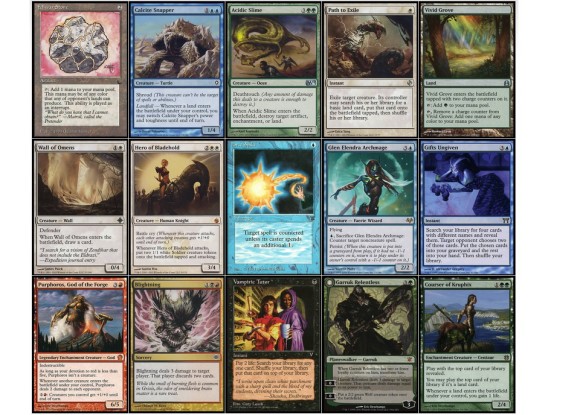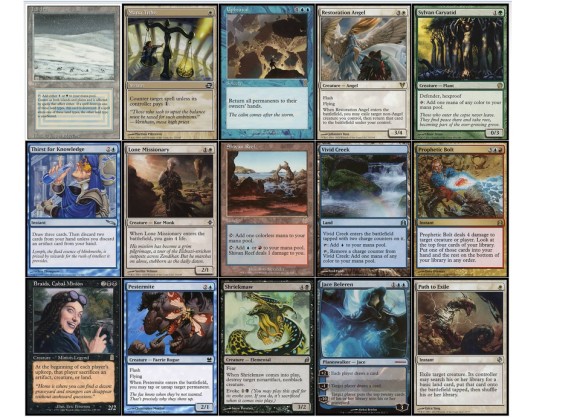More xmage. Don’t worry kids, we max out at 1 X.
Author Archives: Sam
XMage Cube Draft #1
Sam takes you through a cube draft on XMage. It’s radically BODACIOUS!
Pack 1 Pick 1 #29
Another pack 1 pick 1! (pack1pick1magic.com, amirite?) Instead of jib-jabba, let’s get pick-packin’! (I am so sorry.)
Fellwar Stone
Calcite Snapper
Acidic Slime
Path to Exile
Vivid Grove
Wall of Omens
Hero of Bladehold
Force Spike
Glen Elendra Archmage
Gifts Ungiven
Purphoros, God of the Forge
Blightning
Vampiric Tutor
Garruk Relentless
Courser of Kruphix
The cube list: http://www.cubetutor.com/viewcube/15861
This is a strong pack. I am considering Felwar Stone, Acidic Slime, Path to Exile, Hero of Bladehold, Glen Elendra Archmage, Purphoros, Vampiric Tutor, Garruk Relentless, and Courser of Kruphix. The rest of the pack is mainly roleplayers; an argument could be made for Gifts Ungiven, but that argument will not be made by me.
Felwar Stone is the most underwhelming of the picks in a vacuum, but in my cube where there are no signets then artifact mana needs to be prioritizes if that’s the type of deck you make. Felwar Stone is like a first-mode-only Everflowing Chalice that can sometimes fix your mana. The main reason it’s good is that it gives non-green decks a way to ramp from 2 to 4, which is huge. A blue deck dropping a turn 3 Jace or Glen Elendra Archmage will hold its own against a lot of different decks. In this pack Stone is probably not the pick as there are just better cards to be chosen, but there is someone out there probably interested in the stone and I can understand why.
Acidic Slime is a personal favorite, and easily my favorite of the ETB-destroy-artifact variants. (Reclamation Sage is quickly moving up to battle for the top spot, but that’s another article.) Slime is so great because you pretty much always have a not-your-own target, something that Uktabi Orangutan or Indrik Stomphowler cannot claim on their own. There are many times you will want to hit their lands too, as there are many problem lands running throughout all cubes. If you have a Crystal Shard or Recurring Nightmare at hand, Acidic Slime becomes that much more disgusting. A strong card, probably not the best pick here because there are better green cards, but it would be sweet to take one of the other green cards and have Slime wheel.
1 mana removal spells are strong, and Path to Exile is no exception. There are many packs where Path would be the best and safest pick, as so many decks want to splash an easy-to-cast piece of removal that hits almost everything. Giving them a land can suck, but it’s better to force your opponent to have the next threat than it is to not play Path and let them keep beating. Behind Felwar Stone I think path is the safest since it makes the most amount of decks and gives you a reason to splash white if you aren’t there, but I’m less inclined to pick amazing removal if there are amazing threats or planeswalkers also available.
While I’m less high on Hero than when it first came out, Hero of Bladehold is still an utter beating if you’re allowed to untap with it. By itself it’s a 7 power beater on attack, and with other creatures you add more and more damage with the Battlecry. Hero does die to quite a bit and acts like a lightning rod, but in the right deck you can force your opponent to waste removal-removal-removal on the first three turns and then watch them frown as they’re out of gas. In this pack I’d take Path if I’m taking a white card as I like easier to splash cards and game-changing 4-drops are not scarce in cube. Hopefully this changes into the Holiday Cube and I can wheel it in the last 5 picks. This happened a surprising amount.
Glen Elendra Archmage, a card I’ve talked about a lot, and for good reason: SHE’S REALLY GOOD. Two negates attached to a flier as a mimimum is super solid. Resetting that persist trigger any amount of times means you’re probably locking out your opponent from casting relevant spells. Glen Elendra is one of the higher considerations for me because: 1) it’s blue, 2) it’s easily the best blue card, and 3) it’s one of the best card in the pack. If I don’t take it here, it’s worth noting that I’m passing it.
The more I play with Purphoros, the more I like it. Ignore the devotion/creature part—that is a bonus and it does happen, but the most important thing is doing 2 damage any time a creature comes into play. That means blink shenanigans, tokens, regular-old creatures all shoot shocks. The other day on the modo cube I was facing a deck that had me down to 4 life and dead on board. Purphoros was the only reason I won that game, as I was able to do 20 damage to them in one turn. 20! No other card in cube except maybe like Upheaval would’ve saved me there as my opponent definitely had the reach to kill me. The quality and diversity of what the other cards in the pack do means I probably don’t take Purphoros, but I would have to think hard if it wheeled from this pack.
Vampiric Tutor, to me, is the best card in this pack. Cube is a place where most all the cards in your deck are high-quality, and having a 2nd copy of any of them left in your deck is really strong. You lose a card and you take 2 life, but by being instant speed you can find what you want at the end of your opponent’s turn after they’ve made their main phase plays and then get the best card for the best situation. A single black is easy to splash, and I feel like a tutor is worth splashing. Vampiric Tutor is a front runner.
Garruk Relentless is a front runner as well. Garruk is great as he acts as removal in green, which is extremely rare, on top of being a threat generator. Once you flip him, he becomes almost like a Survival of the Fittest with the overrun option at the end. Probably the best part is that he costs 3G, letting many decks splash him and giving so many decks the options of using a card as a continual stream of threats until you feel the need to kill something. Garruk Relentless loses points because there are other strong green cards in the pack, but being easy to cast certainly helps.
Finally there’s Courser, who gives your green decks card advantage on a fairly cheap big-body while gaining you life. Courser lives through a lot, attacks through more, and if your life is of the concern, then the incremental one a turn will help considerably. The biggest drive is playing lands off your deck, which is kind of like drawing cards. Broadcasting to your opponents what is coming off is not stellar, but when that information is better for you to know then your opponent then it’s real easy to sculpt a win.
What would you choose? Let us know in the comments, and thanks for reading!
Holiday Cube 2014 Draft #4
4th time’s the charm, right? As long as it’s not something bad like Rakdos charm.
Holiday Cube 2014 Draft #3
Swiss draft number 3 with Sam. Does he go blue again? SPOILER: he does.
Holiday Cube 2014 Draft #2
Another draft, swiss family cuberson
Holiday Cube 2014 Draft #1
A cube draft I recently did. 3 rounds of swiss.
Pack 1 Pick 1 #28
Let’s do another pack 1 pick 1!
Tundra
Mana Tithe
Upheaval
Restoration Angel
Sylvan Caryatid
Thirst for Knowledge
Shivan Reef
Lone Missionary
Vivid Creek
Prophetic Bolt
Braids, Cabal Minion
Pestermite
Jace Beleren
Path to Exile
Shriekmaw
The list: http://www.cubetutor.com/viewcube/15861
This is quite the pack. I’m considering half the pack, though not all cards are made equal in that grouping. For likely choices, these are my options: Tundra, Upheaval, Restoration Angel, Sylvan Caryatid, Braids, Cabal Minion, Jace Beleren, Path to Exile, and Shriekmaw. The lands I didn’t mention aren’t nearly strong enough to consider; Lone Missionary is filler or a niche sideboard card; Thirst for Knowledge is kind of underwhelming in an unpowered cube; Mana Tithe is sweet but I’d never take it first; Pestermite belongs to a specific deck that is crazy to assume is open at this point; and Prophetic Bolt is kind of boring and expensive here. Beyond that, everything is up for grabs to some degree, and I’d like to go through and consider the pros and cons of each.
Tundra is a safe pick with some upside. Duals are great if you want to stay open, and UW duals are some of the best as splashing for white removal or playing blue in general can be a good call. I am also a fan of drafting UW, as you can either go with a tempo or control build; in both of those decks, Tundra is great since it’s important to be able to cast your spells when you need to in cube as you can’t afford to sit around as your opponent goes through their hand and deck. In this pack Tundra is not the best option as you are passing some top-tier white and blue cards. The blue cards would be a signal to me to go into blue, and the white cards here are easy enough to splash that it would be shocking to see them return in an 8 man draft. Taking Tundra and immediately launching into UW could be crazy, as it’s better to read what is passed to you then what you pass since the people on the right will be supplying you with a majority of your packs and reads.
Upheaval is a classic cube card that has always been powerful, but it’s much more of a commitment in my cube where the powered and fast-mana starts are less abundant. (As an aside I’m considering removing signets as they are really powerful compared to the non-signet ramp available for an unpowered cube, but that’s a conversation in another day.) You need to prioritize the artifact ramp as you see it or go into UG to really see Upheaval’s power in most games. In blue control decks Upheaval is fine as a pseudo wipe, but against a lot of decks you will still need to go through with all the bells and whistles that the original early game presented you with. Upheaval is powerful enough that it’s one of the stronger contenders here, but it’s less of a slam-pick in my cube than it would be in a powered cube such as Sky’s. Regardless, I would be completely OK with taking it here and can definitely end up with a sweet deck.
The more I play with Restoration Angel, the more I love it. A 3/4 flier for 3W with flash is already pretty beefy. She’s a surprise blocker or EOT-attacker a good amount of the time, and then when you flash something with an ETB effect you’re actually swimming in a tub full of gravy…because she’s gravy…get it? Sorry. ANYWHO, cube is full of creatures that do stuff when they come into play, with enough in white that you’re not relying on other colors to make it useful such as Opposition sometimes does in blue. (Master of Waves has helped support Opposition for me; I can understand the reservations some may have with playing a Cloudgoat that murders your kitkins when he leaves, but Master of Waves has been way more powerful in practice than theory.) As a splash Restoration Angel totally works well; a single white is so easy to reach by 4 mana in cube where fixing is abundant. Restoration Angel, like the Path and Shriekmaw, keeps you the most open while still giving you a card that “does stuff” i.e. gives you a powerful effect to work towards supporting or including. Restoration Angel is one of my top choices here.
A big problem in green is keeping the 1-2 land hands that “work” because you have that elf or Wall of Roots that will help you reach your Cultivate/Rampant Growth/what-have you, and then watching that hand and subsequently the game crumble as your opponent bolts or STPs your guy and your draws are terrible. Sylvan Caryatid has given green an option to work around this problem while also performing other roles. At a minimum, a 0/3 body is enough to stop aggression, but adding any color mana reliable on the next turn lets you figure out your future plays much easier. As the only green card in the pack, it sends a clear signal that is worth noting and if you get passed green good stuff you can all but guarantee a second pack that continues to bloom. The sick, ramp-player-4-eva in me would have a hard time passing Caryatid in this spot, and Caryatid is definitely a top contender. Being just a ramp card without giving me a unique or powerful way to interact with my opponent’s board and mess with their lifestyle makes me sad to pass so much good stuff, but Caryatid at least lets me cast my big things without really caring what my opponent is doing. Likely not the pick, but wouldn’t be surprised if it was.
Braids, Cabal Minion is either loved or hated. People either think she’s soul-crushing, or find her kind of useless. Obviously I think she’s great because I’m considering taking her here, but compared to all my other options she’s one of the biggest commitments to a deck. The Braids deck—which uses tokens, recurrable permanents, and an early/faster board to peck away at them as they struggle to stay afloat to take the game away by applying a symmetrical effect in an asymmetrical way—is menacing and kind of like a bully, holding your opponent down by the neck as you give them little slaps to death. There have been games where the turn 4 Braids on the play resolves and your opponent has 3 lands and doesn’t draw a replacement. She is not good against every deck, but where she shines she shines hard and the more focused you are on the Braids/Pox package, the easier it is to still use the attrition to win against other fast/”fast” decks. In this spot I don’t take her as I like to side towards more conservative picks regarding my mana when the power level of my choices are similar. Like, if Jace, the Mind Sculptor was in this pack I take him every time because he’s that much better than what my other options are. But nothing here jumps out as so-much-better, so a more versatile or powerful card would be a better choice.
Jace Beleren is the blue Phyrexian Arena; this is a compliment. Draw 3 for 1UU sounds like a great deal, and Jace is that and more. (More drawn out, but still.) If you choose to tick him down to death, he is a draw 3 for 1UU, as previously stated. If you want to let your opponent draw one every once in a while so you can keep on drawing, he can net you more value if not some life gain from your opponent attacking him instead of you. And if you have the game on lock without a typical win-con that attacks for damage, Jace’s + ability will mill most decks by that point when you can reach a point to activate it. Jace is like Braids here in that I’m more likely to take a different or more powerful card because of how much of a mana commitment it is, but I am a moth at times with magic and blue can be the light that shines the brightest. (Ignore previous “green-4-lyfe” mumbo-jumbo.)
Path to Exile can be worse than Swords to Plowshares, but we’re comparing gold to platinum here. Fairly unconditional removal of a creature permanently is highly sought after when graveyards can be abused in an abundance of ways. Against reanimator or regrowth decks killing the threat cannot be enough when they return it soon after. At one mana it’s easy to keep open, and one of the best pieces of creature removal. The drawback is not negligible and definitely is worse than giving your opponent life, but there are many points where they can do nothing special with that basic land and giving them that card in the form of a land is a sweet trade. Path to Exile is a safe pick here and a top consideration, but probably not the best one.
Shriekmaw is really two spells: a sorcery doomblade, and a 3/2 fear doomblade for 5. The first part is nowhere close to cubeable at this point, but that ability attached to a creature with evasion is awesome. Being black is so much better for Shriekmaw as you have graveyard shenanigans that turn Shriekmaw into a 2+ for 1. I feel that Shriemaw is kind of underrated since the five-mana version is kind of expensive for a 2 toughness creature, but perhaps I’m delusional. It can be dangerous to splash for Shriekmaw as the real black deck will nullify his ability, and if they can somehow blink or bounce their non-black creatures then there are times where you are forced to destroy your own creature—that is shitty. But that is also quite rare. Shriekmaw is great. Shriekmaw could be the right choice here, but I don’t know—it’s a tough decision!
Ultimately I think I’m going to take Restoration Angel. Upheaval has the higher upside, but Restoration Angel comes down faster while also giving you the option to blow out your opponent in so many different ways. Caryatid is the only green card and a strong one at that, but Restoration Angel is enough stronger to make it a no contest.
What would you take? Let us know in the comments, and thanks for reading!
Retro Review: Innistrad
Innistrad is one of the most important sets in magic’s history. Magic was rising in popularity but also was coming off a standard format where they had to ban 2 cards in Stoneforge Mystic and Jace, the Mind Sculptor. Magic could not afford a slip up, and Innistrad did not disappoint. The flavor was top-notch, the power level was high, the set proved wizards could do crazy things like double-faced cards and not lose all their customers, and most importantly Innistrad gave us a boatload of cube cards. Today I’d like to take a look at Innistrad’s possible Cube inclusions and talk about why they do or do not work. SO LETS DO THIS.

Ambush Viper: Green has always been desperate for removal. Playing the biggest baddest creatures as early as possible is nice and will win you games in the same way that you can smash a square peg through a circle hole and it will still work, but a lot of the time it will be awkward or you’ll get stuck on board facing things you can’t attack around or afford to take a swing-back from. For a little while, some people including our playgroup toyed with Ambush Viper with mixed results. Like Deadly Recluse in core sets, Ambush Viper was kind of like a green Doom Blade—or at least called as such, as it cost the same and often ended up killing something attacking you. As a limited card, it was very good since you could effectively use it on defense for the death touch reasons and offense as a 2/1 for 2 is about the base-line of what you want in a cheap threat.
There are some issues with Ambush Viper as a cube card. For starters, it’s a bit clunky in terms of killing what you want. If my opponent suspects that I have Ambush Viper at all, he can play around it all day and I’ll either have to make the trade for a lesser creature and still have the problem card to deal with or let it shed endless layers of skin in my hand as I try to still hold it up. The threats in cube are too efficient to let them remain alive on the board, and you need to be greedy with your cube spots so “doesn’t target” is a pretty legitimate gripe. A 2/1 is a pretty lame body and it dies to everything as well. Death touch mitigates a lot of the good blocks someone could make, but there are a lot of spells and abilities that laugh at the puny Viper. If your cube doesn’t support green aggro at all, like mine, then Ambush Viper is decidedly worse in that it turns into a strictly-sideboard card. I don’t think Ambush Viper is horrible, but it’s not what I want to be doing in green at mid-to-small sized cubes.

Avacyn’s Pilgrim: People either love this card because it’s an elf that makes off-color mana or hate it because it can’t produce green mana. Personally as long as the mana is colored and the elf costs 1, I’m pretty happy having another option for 1-mana green ramp. I can understand the argument for wanting the elf to make green. There are a lot of heavy-green-symboled cards that work in green because so much of the ramp produced green. If Garruk, Primal Hunter or Vorapede were color-switched to blue or white, there’s way less of a chance we still play with those cards. Other colors can’t guarantee that their own cards can help cast other cards within their colors, and green is quite alright with high-devotion spells.
On the other hand, you’re rarely forced to make more than 3 green mana for your spells and that is in the minority. If I played my Pilgrim, by turn 4 I should be able to cast any GG spell and turn 5 any GGG spell since the rest of my ramp makes green. A Courser on turn 2 can be awkward, but a t3 Courser is on curve and the tempo-kill is rarely seen. White has the best removal that’s also the easiest to splash, so Avacyn’s Pilgrim is a main-deckable card that helps you splash that O-Ring or Swords to Plowshares. At first I had major reservations about not making green mana, but after years of playing with Pilgrim I can count on one hand how many times not making green mana has lost me games.

Blasphemous Act: On paper, this card should be great. 13 damage kills almost anything you could cube, and it’s a wrath so you should be using it to kill a bunch of creatures anyways, right? But what if there are only 3 creatures on the board that have to die? Is a wrath for 6 any good? What’s the threshold of creatures on the board where this is cubeable? If you play Boros Reckoner there are former standard-dreams to live where you can send 13 damage at someone’s face or creature, but Reckoner is not the most commonly card and that is quite the niche application. In addition, there are much more consistently-castable wraths in red that don’t require you to have a bunch of things on the board before you can cast it, as you typically won’t need to pay 13 for X on your Earthquakes and what-not to clean everything off. Even in the largest of cubes you can probably find a better option for red wraths.

Bloodgift Demon: While a fine beater that has performed well for me, Bloodgift Demon’s spot isn’t in stone and I’m ready to improve on him whenever. Drawing cards, a 5/4 flier for 5, that’s cool and all but for a cube finisher it feels kind of lame. 4 toughness is actually pretty small for your top-end guy and he can potentially die to a lot. Bloodgift Demon is a pretty lame reanimator target too, which is what I want my black finishers to double as. For 1 more mana I have 10+ power in Grave Titan, and the drop off from Titan to Bloodgift Demon is massive.
While the last paragraph was harsh, that’s because I’m a tough critic for cube cards—Bloodgift Demon IS a good card and has won a lot of games. I mean, 5/4 fliers for 5 that can draw you cards have to win some number of games, and you can even use the draw-effect on them to deal the last 1 or 2 damage. I’m perfectly fine running Bloodgift Demon and if I’m playing black I’ll probably run it in every build except 15-16 land aggro builds. In the long term there will probably be a better 5-mana creature or other type of spell printed (cough cough, Ob Nixilis planeswalker, cough cough) but for now Bloodgift Demon is a fine option.
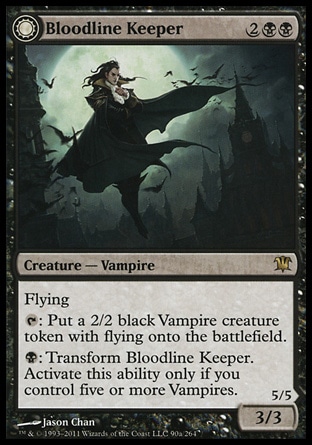
Bloodline Keeper: While BK was one of the best cards you could crack in triple Innistrad draft, it was a bit too durdly for cube. I don’t want to make 2/2 fliers every turn with my 4 drop that dies to incinerate, and I certainly am not playing him as a 3/3 flier for 2BB. Like, unanswered Bloodline Keeper is fine, but if you can’t untap then he’s kind of the worst. There are just better things you can be doing at 4 mana. But hey, if you want to play him, have it your way.

Bramblecrush: Like I said earlier with Ambush Viper, green is desperate for quality removal and Bramblecrush does hit quite a lot. 4 mana is a lot for removal, but green doesn’t have a problem ramping up to 4 mana. Not hitting creatures kind of sucks, but that would be a very non-green effect so it does make sense. Hitting everything else though is sweet. Planeswalker? Equipment? Basic land? Bramblecrush has you covered. Bramblecrush is not an exciting card and with Song of the Dryads recently coming out Wizards has shown that they will print cheaper removal with not-so-bad detriments that can actually stop creatures to a point. Bramblecrush is solid; never a high pick, but your green decks are OK maindecking it if not happy to bring it in from the board.

Brimstone Volley: A reasonable card, Brimstone Volley always hits for 3 which is fine but hits for 5 way less than you like, which is the reason why you would include the card. Morbid cards are a lot easier to justify in black where you have more ways to sacrifice your own guys, but you typically need to go through combat first or have another spell to trigger the morbid, which can be awkward. 3 damage will work in a lot of spots, but at 3 mana for that you’re pretty disappointed in terms of a cube card.
Brimstone Volley is one of the better cards to splash in red as in a lot of non-red strategies you can find yourself triggering morbid. Black uses cards like Braids, Cabal Minion, Smallpox, and Flesh Carver to sacrifice their cheap, recurring creatures and punish the opponent’s unlikely similar strategy. Sacrificing your Bloodsoaked Champion or sending him at a wall of good blocks that could seem to be just testing the waters turns 3 mana into 5 damage, taking a quarter of the opponent’s starting life off or removing a lot of different creatures. Tokens in either white or black will swing en masse pass 1 or 2 blockers and Brimstone Volley can follow to seal the deal. Green creatures will make your opponent chump, then use the Brimstone Volley to kill another guy or the planeswalker you were trying to remove. Blue? Uh, maybe you got a Lightning Bolt instead. Being one of the better red splash burn spells isn’t a reason to run Brimstone Volley if you hate it otherwise, but I can understand the arguments for larger cubes.

Cackling Counterpart: 2 clones for one card at instant speed, though they must be your own creatures. Still seems kind of great in theory, but regular old Clone was better. The second half of the card was too overpriced for what the first half gave us. Three mana is cheap, but UU makes it the hardest to cast consistently cubeable clone—sick alliteration, bro—behind Phyrexian Metamorph, Phantasmal Image, and Clone. (Dack’s Duplicate is really good, but it’s not competing with Cackling Counterpart.) You can’t splash for a Cackling Counterpart, nor can you return it from the graveyard or bring it from your hand to play. Not copying what your opponent could have was the worst overall. There are just as many if not more times you’re copying one of their creatures if not your own, and a good portion of those times you wouldn’t have a creature of your own to target as is. Cackling Counterpart has proved that a self-serving clone needs to be a lot better than a built in 2 for 1.

Champion of the Parish: At the time there were not nearly enough cubeable humans for the champ, and I’m still not sure there are, but it will be worth revisiting him in the future if the cube’s composition shifts more towards the human tribe. Also, “human tribe” felt weird to type, suggestions for something better in the comments appreciated.

Enemy Check-Lands: I’ve always liked these cards. They’re the best fixing to have other than ABU duals and sometimes over fetches if you’re light on fixing overall in your decks as they will consistently come into play untapped. The more colors you’re playing through your non-basics the much worse they get, but for some decks any fixing would be good enough. Which ones you include are most likely dependent on how you organize your lands and your multicolored cards as you may have only a certain amount slotted for lands of a type or perhaps your lands are sorted with the guilds. They are all playable and a cube could get away with running all of them, with more ease as your cube grows in size.

Cloistered Youth: A good aggro card, Cloistered Youth will never be the best card you ever played with but is a serious clock at an easy cost. Cloistered Youth is pretty much a 3/3 that hurts you, but at the end of turn which is super sweet. There will be games where your own black creatures will kill you right as you attack for lethal, and Cloistered Youth not only gives you a pain-free turn at first but lets you attack before she taxes you. The pain-free turns can last as long as you want, not punishing you for being stuck against a bigger board and letting you clear the way before you starting hurting yourself a little. Being a 1/1 while all this happens means that she’ll die to anything, which does suck, and means that Cloistered Youth does not have a permanent spot in any cube. There will hopefully be better 2 drops printed that follow trend of nice aggro support, and there could be a decent amount of cubes that doesn’t think she’s worth it, but she is a good inclusion as aggro support and will always bring pain en masse.

Curse of Death’s Hold: It’s a strong effect. Enchantments are hard to remove and -1-1 is small but when permanent is tough to deal with. Any token build crumbles and there are enough X/1s floating around to shake in their boots. At 5 the effect is a bit expensive for my liking, but I’ve seen it floating around at the end of packs and not been completely disgusted.
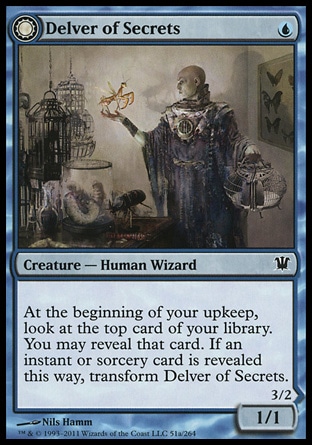
Delver of Secrets: As of writing this article I run Delver and I’m still debating on cutting or supporting it more. Delver of Secrets will probably end up back in the binder, which is a shame because I love the card, but even in the tempo builds I don’t find that he flips enough or even that the 3/2 flier will matter. It’s so much harder to protect your Delver every game turn after turn than it is in eternal formats where you can build your deck to perform to maximum efficiency. In cube where it’s a singleton format you only have access to so many counters that cost 2 or less, and as cube becomes more and more popular and more are coming together you can’t depend on every cube you draft that can afford a delver will be able to afford a Force of Will, one of the classic cards to pair with Delver. (Along with any other Legacy blue cards.)
If I ran more cards in the spells-matter deck and me and the people I played with loved that deck and tried to draft it more, Delver would be an auto include because he is so good in those decks that can play him t1 and flip him t2. But I don’t think the typical cube control decks want to spend all their resources fighting over a 3/2 and any deck with any amount of reasonable creatures to be called a tempo deck will have enough non-creature, non-instant/sorcery cards to not flip Delver. Delver is the classic “all-star constructed subpar cube” card.

Desperate Ravings: People who played a lot of Innistrad block think this card is cubeable and actually good in cube because of how much fun it was to play in constructed and limited at the time. However, like Delver, the decks where Desperate Ravings showed up were made to use the card with maximum efficiency and reduce the pain of discarding a card you couldn’t use again as much as possible. There are only so many UR cards in cube that can re-use the graveyard, and in decks where that effect doesn’t exist at all you can’t afford to pitch important cogs and win conditions. There isn’t a “random” card I like for cube for that reason.

Devil’s Play: I like to run one red X spell. My brother ran Devil’s Play for a while and I don’t think he runs it anymore, not because it was a bad card but because there were better options. Built-in 2 for 1s are great as you want to get as much out of your cards as possible, but at RRR the buyback means any deck splashing for the first half will almost if not straight-up will never cast the second half. Without the second half Devil’s Play is clearly worse than Red Sun’s Zenith, Fireball, and Bonfire of the Damned, and I’d only run 1 and maybe 2 of those if I wanted both Bonfire and a more direct damage spell. I don’t think Devil’s Play is a horrible inclusion, but there’s no reason to run it in mid-to-smaller lists if you’re looking to run the best cards unless your nostalgia is playing a bigger part in the decision making.

Diregraf Ghoul: Black is good at aggro, so Diregraf Ghoul is good. The ETB tapped clause is unimportant since you’re not looking to block with Ghoul anyways, as a 2/2 for B is built for speed. Diregraf Ghoul is important as a compliment to Gravecrawler, which is so much better when you do have buddies to share. The Ghoul is unexciting but in order to support aggro you need to run it.

Doomed Traveler: Sky ran him for a while. 1/1 fliers are kind of neat, but you have to put in some work to get one. If Xanthrid Necromancer ever proved to be a staple then Doomed Traveler should be reconsidered to pair along with Champion of the Parish, but as a creature without tribal bonuses 1/1s followed by 1/1s is often followed by yawns.

Fiend Hunter: While I can understand not running Fiend Hunter as it’s not the craziest card, it’s good enough at removing creatures while having a defensive body that works with the effect. I run both Fiend Hunter and Banisher Priest and find that the 1/3 is better. My aggressive decks do want to remove threats but they don’t want to give my opponent the choice of putting a lethal blocker in front of Bannisher Priest, returning the creature that was a big enough issue to be removed. With both tokens don’t last, but if I decide to only run one it’ll be Fiend Hunter. Bannisher Priest will come out if I ever get a Brismaz or any other 3 drop I don’t have, though I do like having one of those types of creatures for now.
Fiend Hunter is fun because you can pull some Crystal Shard shenanigans. Play Fiend Hunter, with the trigger on the stack return it to your hand, and before the trigger resolves the Fiend Hunter is gone and therefore can’t trigger the second part of his abilities. Yay magic!
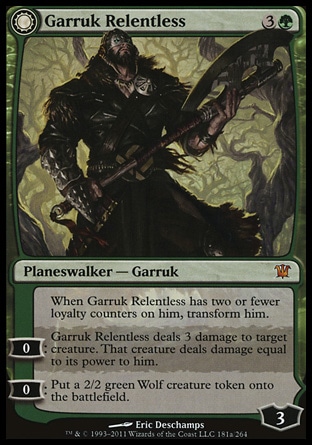
Garruk Relentless: One of my favorite cube cards, Garruk brings the beats. He’s one of the few green cards you want to splash because 1) you can, and 2) he’s a threat that can win the game on his own. Garruk is worse in planeswalker super friends then some other planeswalkers as the back side can’t fetch as many good creatures nor give much of a bonus with the ultimate, but 1/1 death touchers are great blockers and at times have pseudo unblockability, and even +1+1 and trample will be enough to kill. Garruk dies to quite a bit of burn, but you will either be able to kill something or have a 2/2 left. I like this card a lot, and have written a lot about him on the site; in fact, he’s my #6 favorite planeswalker on my top 15 planeswalkers list, and while that list is outdated he’d still make a top 15 list re-done today.

Geist of Saint Traft: This is another card that performs much better in constructed and the original limited format that in cube, but there are quite a bit of cards that are excellent with Geist the cubes run and he is great in the UW tempo decks or a control deck built to protect him from non-targeting removal. The UW/UWx delver builds in constructed either feature Rune-Chanters Pikes + tons of instants/sorceries to kill any blocker that could get in the way on the ground while continuing to go over the top. In regular triple ISD limited there were only so many answers to Geist and the UW fliers deck was a strong, fast deck in a good format where there were a lot of great tempo cards.
In cube? There are plenty of viable decks that don’t really care if just a 2/2 and a 4/4 in the air that’s attached at the hip to the 2/2 are attacking each turn because they can either happily trade by the turn 4 attack or are much faster than when Geist can get into action. At the other end of the spectrum, cube also features all the swords and plenty of counters and removal, with a plethora of non-blue archetypes available you can face that’ll give you time to set up your Geist and keep him alive. If I owned a Geist I probably wouldn’t play it as azorius is a tough archetype to get into and I’d rather run other cards, but he is a nice option if the UW tempo decks are highly drafted in your group.

Geist-Honored Monk: Cloudgoat Ranger is better. Geist-Honored Monk is a sick card, but there are other better five drops. Having Geist’s P/T dependent on the number of creatures you control seems good in theory with how you’ll want to blink the card, but removal is so good in cube that something like Pyroclasm kills a Geist-Honored Monk and his pals if they’re all you have whereas Cloudgoat Ranger would still be chilling. Even attacking and blocking can be awkward as removal or even blocking one of the 1/1s means you lose the monk. G-H M is cool in a larger cube probably, but spots are too tight when you’re small.

Intangible Virtue: If the token deck is heavily supported and heavily drafted, then a two-mana anthem is very good in that deck. If it is not, then Virtue is pretty kaka. Tokens good, no tokens bad. GOT IT? GOOD.

Kessig Wolf-Run: At the beginning of Wolf-Run’s time, I had minimal respect for Wolf-Run as a cube card. Not that the effect was bad, but the cost to do it seemed like a lot to sacrifice the ability to tap for mana. As time passed, I was killed enough by Wolf Run to gain the respect it deserved. It’s not a card I’d necessarily go out of my way to get, as it can be an awkward card to fit into your cube, and it’s not so powerful that I feel like I would need to include it in your list. Where it shines is in the green decks that I personally love to draft. If your win con doesn’t have trample, you can’t afford to attack, or they’ve removed it and all you have left are your elves, Wolf Run works in all of those spots. Removing lands is tough for any deck as there are so few pieces of spot-removal for lands, so your Wolf-Run will live where a lot of other end-game threats will die to a lot of the removal. Wolf-Run is the weird card I would recommend if you’re looking to change up your cube but completely understand if you’ve had bad experiences with it, as it’s not always the bomb diggity but does indeed go boom.

Laboratory Maniac: If you run this, you’re the maniac. But you got spunk, kid; guts, chutzpah.

Liliana of the Veil: One of if not the best card in the set, Liliana is the rare card that attacks your opponent’s hand and board. At 3 mana you can usually drop Liliana at a spot where you have a blocker in case you need to edict or they just don’t have another creature. That early in the game the control decks might not be ready to deal with the Liliana yet, and after a few +1s they are in serious trouble. Liliana supports your own graveyard strategies as well, letting you attack your opponent while you do what you wanted to anyways. Since she lands so early, you can reach and activate the ultimate easier than a lot of the other planeswalkers, and the ultimate does work.
Liliana also works in every black strategy. Aggro can use her as repeated removal of creatures and their hand so you can kill them quick and efficiently. Control will mitigate the discarding by drawing extra cards and it’s a lot easier to deal with your opponent when they have no cards in their hand. Seeing a passed Liliana is a clear sign that black is open, and any cuber that has any experience with magic from that set or cube in general will recognize this. Liliana is a staple.
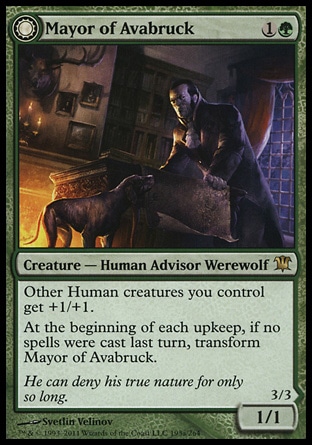
Mayor of Avabruck: If Humans were a better tribe, Mayor would be better as the back side supports itself while the front is pretty lacking without other humans. If you’re not flipping Mayor, which if your opponent doesn’t let happen can be painful to force on your own, then your Mayor typically won’t have other human friends to make big. A 1/1 for 1G proved to suck too often.

Mentor of the Meek: I like Mentor, but understand that it’s a bit weak and probably not worth a spot. Mentor provides card advantage in the aggro decks that typically can’t draw cards, turning your top-deck Savannah Lions and Isamarus into bears that draw you card, good deals when you need to fill the board up without any other way to draw extra cards than the one you’re allowed each turn. In token builds you can draw multiple cards in a turn if the mana is open depending on what your token maker is. A 2/2 for 2W is kind of weak on its own, and there are certainly games in the faster decks where you won’t have the mana to mentor the meek. There will be a point where Mentor will be tough to argue for a spot, but for now I understand the love.

Mikaeus, the Lunarch: Mikaeus is a lot better when you heavily support token builds, and is a lot worse when you don’t. Sometimes it’s really awkward in figuring out whether to make him bigger or make your team bigger, and if your deck isn’t spamming the board then Mikaeus is kind of shitty/slow. You can’t afford to slowly pump him up, and making 1 or 2 other creatures a little better will be underwhelming most of the time. Making 3-5 tokens go from 3-5 damage to 6-10 is really good, and when those decks are being built consistently then Mikaeus is your guy. At that point he’s a slower, permanent anthem that gives your team the size to end the game quicker and earlier before you need to get a giant token army that would typically do the job, or let that army take 1 or 2 turns less to kill.

Olivia Voldaren: When you have the mana available, Olivia Voldaren will take games over on her own. Her ping ability clears off a lot of boards, and whatever she can’t kill she’ll bring to her side. As she grows bigger its less important what lives that you take, since Olivia will fly over the rest of the creatures. She’s a threat you can use on her own to warp the board and make the game go your way.
Olivia probably is not good enough for smaller Rakdos sections. RB is often the aggro combination since the creatures are smaller and faster, and something like Falkenrath Aristocrat is better for forcing the damage in faster. Olivia is more like a snowball, taking a bit to get going and then becoming hard to stop once she had a few turns to go unchecked. I like seeing Olivia Voldarens in cubes but understand why she wouldn’t be included since Rakdos is a tough, tough color to crack.
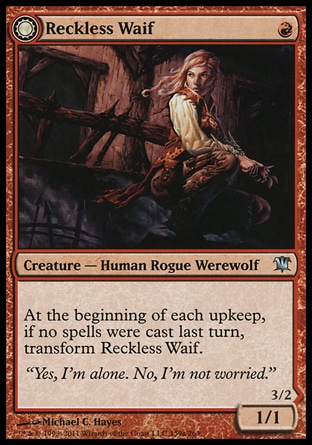
Reckless Waif: A OK card, Reckless Waif is kind of a necessary evil since it is so good in the mono red decks on the play. There have been enough times where it hangs out as a 1/1 and any other red 1 drop would be better, but flipping her makes her the best 1 drop in red you could have. Her power level is a bit bi-polar, which frustrates me and hurts her in my eye. I like consistency in my cards and need a much higher ceiling if the card is swingy in power. Reckless Waif is right on the border of being too inconsistent for my liking as after turn one Waif is really bad, but red kind of needs the one drops so Waif is good for those cubes.

Skaab Ruinator: Did you know this card after it was spoiling up until the release of the set was being priced around $40? You can buy around 80 of them for that much now. Not a cube card, I just always love to share that as a reminder that you shouldn’t always buy into the hype.

Snapcaster Mage: There are many sick, gross spells in cube and more in a powered cube, and at two mana Snapcaster Mage is able to flash so many of them back with ease. Whether you’re holding up a counter without holding the actual counter, drawing way more than the card says you can, or copying a removal spell to take out all sorts of creatures, Snapcaster lets you recycle cards you already gained value from. As a two-power creature you can do enough damage with Snapcaster to at least make a dent, if not use him as a compliment to other creatures. Snapcaster is a staple, and is very very good. If you understand that cube spells are good, then you understand why Snapcaster is good.

Stromkirk Noble: Stromkirk is slow to get going up to the speed you’d like, but makes up for it by severely upgrading his body where many other 1 drops stay stagnant. The human clause comes up enough to be relevant, and on turn 1 there are few plays across the table that consistently and profitably stop your Noble from strolling on in to beat-town USA. If they keep on printing good 1 drops there will probably be one that will be better than Stromkirk Noble as if you stutter and they don’t, then the Stromkirk does give them enough time to stop him before he deals any kind of sizeable damage. By the time Stromkirk deals one or even 3 damage, every other good red 1 drop has done 4+ damage on its own. Stromkirk in the long-run does more, but how many games are going long enough to use that damage without doing it too slowly? So far enough, but enough have gone the other way to yearn for something better.

Tribute to Hunger: If you need two instant speed sac effects, then Tribute is probably fine since gaining life is enough of a bonus for the control decks that want this kind of card. If I had an ideal cube where availability wasn’t an issue I don’t think that Tribute would be necessary, but if I’m looking for another removal spell and I have all the others I want or want to add another instant-speed sac effect, Tribute to Hunger is strong enough to help me pull that proverbial trigger. But ultimately, meh. Take it or leave it.

Unburial Rites: For a while Sky ran this and it was good there, but orzhov is too tight of a guild and at 5 and 4 mana Unburial Rites is too expensive for reanimation. When you have the time to spend the mana its good and you can pitch the card. There is also the Gifts Ungiven trick where you find rites and another fatty, forcing your opponent to throw both to the bin and let you tutor out a reanimation. My reanimator decks don’t like to wait too long or spend too much mana to bring their guy back. If I’m not pulling my first reanimation off on curve with the spell’s cost, I want mana available to protect Unburial Rites with counter magic or be able to kill anything that gets in the way. I like Rites in a big card since it is good, but I have a hard time including it with how good the BW cards are at the top of the section.

Victim of Night: This card kills a surprising amount of creatures, but BB is a hard cost to justify and it is kind of awkward when you do run into the issue. The cost is the bigger issue, since there are more Vampires and Zombies in black than the other colors so this card acts more like Terminate than Doom Blade. But like Terminate instead of Doom Blade you can only fit a BB card in so many decks. You have to want the effect in your cube to be OK with the cost, and I’m OK with the easier to cast or stronger removal that black offers otherwise.
What did I miss? Let us know in the comments, and thanks for reading!
Commander 2014 Cube Review
The Commander sealed products are always great for cubers. Wizards must partly design the cards for cube play, as every commander set has had at least 1 staple involved. This year is no different, and in fact might be the strongest set of cards that are cubeable so far! So without further ado, the cards:
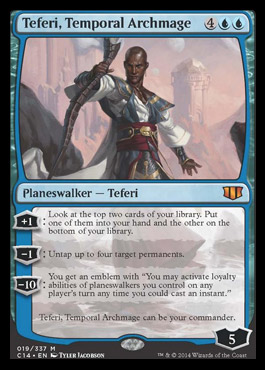
Teferi, Temporal Archmage: I’ve read justifications where people say this guy is good because he’s either a 6 loyalty planeswalker that netted you a card or he can be a 4 loyalty planeswalker for free with the untapping ability. For 6 mana I’m not impressed, and as a baseline for planeswalkers that is not what I’m looking for. Cube is full of 6 mana cards that are way better and binders are full of 6 mana cards that are just better than Teferi in so many situations that aren’t being played that a planeswalker which gives me underwhelming card selection/advantage or untaps a bunch of stuff just isn’t going to cut it. I want my Planeswalkers to give me threats, protection ,or more than a card. And where other free spells are sweet in cube like Time Spiral and Treachery, you gain tangible results immediately with those cards. If I lose my Teferi the next turn, does it feel like I’ve gained anything but a 1 for 1? Perhaps in the largest of cubes or if you heavily support Time Vault combo he could find a space, but I’d rather a creature I can reanimate or a spell that does more.
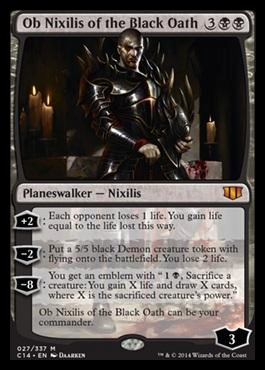
Ob Nixilis of the Black Oath: Slob has been re-done, and holy crap is he awesome. He is essentially a 5/5 flier factory, and at the low cost of every other turn and some life that sounds like a sweet deal to me. Making 5/5 fliers for loyalty counters and some life is really good, and that’s the only ability that really matters. The other abilities might as well be blank because they don’t really register for me in terms of rating this card. Making up a point or two of life with the +2 ability does making the self-draining demon hurt less, but even if that ability did nothing I’d be excited about this card. That’s how amazing making 5/5 fliers is, it’s A-OK as a sole ability. Unchecked Ob Nixilis is a thorough beating, and even with some resistance a 5/5 flier will stop a lot of attacks and kill players quick. Ob Nixilis is insane with the Wildfire packages since both him and his demons live through the burn, adding another planeswalker you want to pair up with Wildfire and Burning. He’s a hard threat in cube, which is full of big bad beaters
The biggest issue with Slob is that he isn’t a creature. Black is huge into reanimation, and having fatties that you can’t pull from the graveyard is a liability in the mid-to-smaller cubes in that color. There is only so much space for top-end fat, so if you were to run Ob Nixilis you probably couldn’t run too many other non-creature curve toppers. But how many others in black do you really want to run? Sorin Markov is past his time, and outside of Academy Rector-supported cubes I’d never cube with Yawgmoth’s Bargain. Perhaps I’m missing some other options, but it seems OK that Ob Nixilis would be the only non-reanimateable fatty. All the evasive power that Ob Nixilis pushes out is worth not being able to bring him back from the graveyard to play.
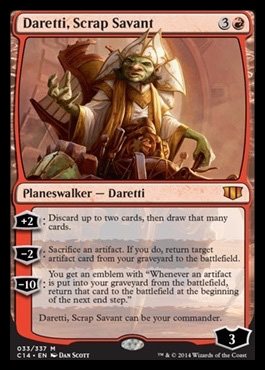
Daretti, Scrap Savant: He is tough to judge. On one hand, costing 4 is not bad for a PW that loots and Trash for Treasures for his abilities. On the other hand, do cubes really want that? Personally I don’t run Goblin Welder as I never have big enough drafts with my playgroup to insure that the artifact.dec in red is consistently drafted. Welder is a lot worse when you aren’t getting all the artifacts you need in the draft pool, as you’ll be either missing the low or top-end. While Daretti is fine if you can’t pull that deck together as a looter, is that something I really want at 4, a spot that is tight across the board? Is fine OK for a card that is taking of valuable space? Including Daretti into your cube is very cube-dependent and playgroup-centric, since your players need to want to make that deck to need Daretti. He seems to be amazing in those decks, as multiple Trash for Treasures can blow games out quick, but he may also be too slow at 4.
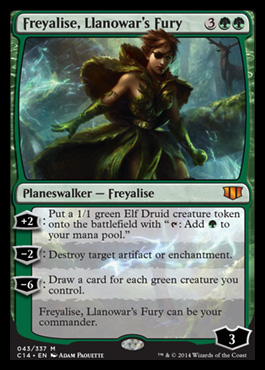
Freyalise, Llanoway’s Fury: Repeatable Naturalizes are cool, but for 5 mana in green there needs to be a much better upside. In fact, you really have to work for those repeatable Naturalizes since she starts at 3 loyalty and you’re certainly not playing her because she makes elves. If Freyalise started at 5 loyalty I’d consider her more as 2 Naturalizes unanswered is OK, but there are better 5 drops in green that I’m not playing which put a ton of pressure on my opponent, which is the type of ability I want to ramp to.
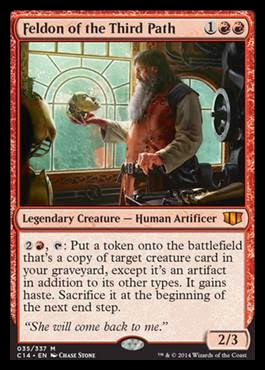
Feldon of the Third Path: If red is drafted a lot as a reanimator color, then Feldon is a staple. If the Goblin Welder deck is drafted a lot, then he’s still a staple. Feldon is really cool, giving the reanimator and Welder decks a new and sometimes (often?) better way of bringing your fatty back, as you can activate it during your main step or EOT so you can potentially swing in with two of the same giant thing. Even without both of the above being true, Feldon is sweet in any cube where red is not strictly aggro-only, which I imagine would be a majority of them. There will be times where Feldon is a lot worse and you need a creature to enter the battlefield and stay there, but if blocking is the concern you can always hold him up on your opponent’s turn. Feldon gives your red side of things a unique angle at the reanimator concept, letting you trade a permanent presence for repeatable hastey guys. If you run Eldrazi Feldon finally gives you a consistent way to bring them back from the dead without losing them, as you activate Feldon in response to the shuffle trigger from the Eldrazi.
As my cube is currently situated, I’m middle of the road. My players and I don’t always go for Rakdos Reanimator builds, but with Feldon around I could see it being an incentive. Is Sneak Attack a necessary tool to make Feldon good enough to include? My instinct says he’d be good without it, or maybe Feldon is the one that gives Sneak Attack another point of legitimacy? I have mixed feelings about Feldon. Good! But mixed.
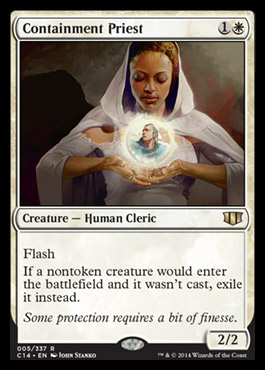
Containment Priest: In the largest of cubes where your sections could have room for silver bullet cards like Priest she might find a spot. The effect is super powerful, hosing reanimation and other cheating strategies at a cheap cost with an acceptable body to boot. But if you’re not stopping something from coming in then a 2/2 with flash is pretty meh. In the mid-to-small sized cubes you need either wider-spread hate bears or guys with evasion, since you can’t afford to be main decking a bear with flash in your aggressive decks. I’m not a fan because of my cube size, but if I went to 720-1000 I’d at least see if I had room for her.
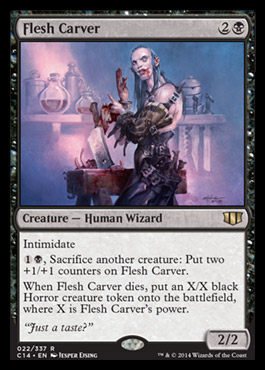
Flesh Carver: Holy shit! Flesh Carver is insane. A 2/2 with intimidate as a base is OK. A solid limited card that always makes your black decks, but certainly not cubeable. The sacrifice effect makes Flesh Carver a pretty sizeable threat, along with working with many of the black cards. Whether it’s the recurrable creatures like Bloodsoaked Champion/Gravecrawler/Reassembling Skeleton or any of the many token makers, there are a lot of ways in black to abuse the ability. With these stats, I think Bloodsoaked Champion is a fine card, and…
…wait, when it dies it replaces itself with an X/X where X is equal to its horror? Jesus, that is nuts. If they answer it right away, you have a 2/2 which is fine for an immediate replacement. If you can activate the sac ability once and it resolves, you now have a 4/4 which is super hard to deal with after you’ve already dealt with one 4/4. You can see where I’m going, as a 6/6 as an 8/8 etc. are better and better. I think, over time, Flesh Carver will prove to be one of the best if not the best black 3 drop for cube. I might like Nighthawk more since it performs in multiple roles pretty effortlessly, but as an easier to cast card that not only performs multiple roles but becomes one of the best cards in certain archetypes, Flesh Carver seems like a swiss army knife of black doom. Beyond that I’d need to be convinced that any other 3 drops is better. Sign me up. Now.
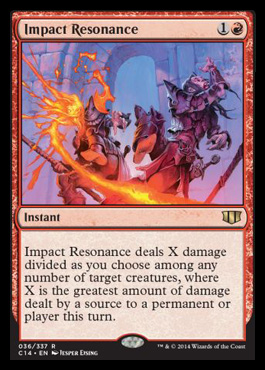
Impact Resonance: Time for an exercise: think back to all the cube games involving red that you’d played in or seen. Replace burn you have with this card. Is it way worse? Is it actually unplayable in a lot of spots? The best case scenario of Impact Resonance might be an insane blow out, but ignoring the worst case scenario of “dead card that I wish was anything else” is not a price I’m willing to pay to include a card. If you’re running all 3 of the incinerate variants I could understand wanting to switch things up, but you’ll get sick of people complaining how Impact Resonance lost them the game by being uncastable quickly.
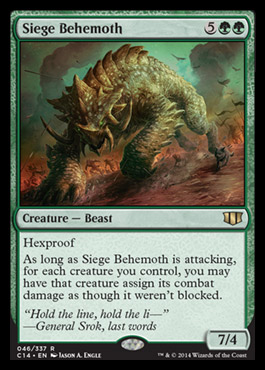
Siege Behemoth: If Craterhoof Behemoth needed to attack or something to activate his awesome ability, I could see Siege Behemoth being better since it will make it to combat more. But if you’re Craterhoof is triggering its ETB effect, then you’ve mostly likely lost as your team will still get some bonus + the trample. Costing 7 is not that much of a benefit to make the switch, and do cubes really need the Craterhoof effect? My cube would have to be pretty large and my players would have to be pretty loud about Siege Behemoth for me to include it at all, especially over the better-and-similar Craterhoof.
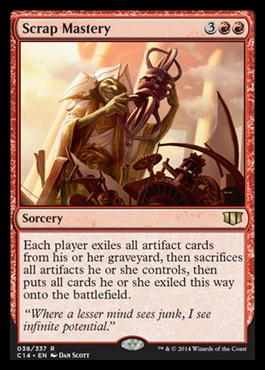
Scrap Mastery: It’s a nice idea, but like I’ve said earlier, I would have to be heavy into the Goblin Welder decks and archetypes to want to include Scrap Mastery. It’s an amazing card if you need something to be picked 15th every time. Perhaps down the line there will be enough for me to want to support it, and if the artifact deck is drafted a lot then Scrap Mastery is a one-sided Living Death a lot of the time. Not for me, but that doesn’t mean it’s not for anyone.
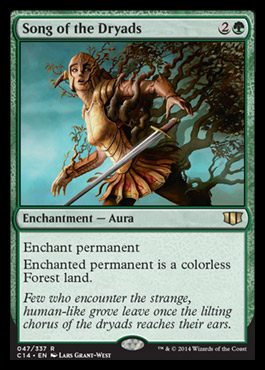
Song of the Dryads: Daaaamn, that is what green needs. Creature removal has always been one of green’s biggest issues, so why not give them an o-ring variant that deals with everything? Giving your opponent a land is not negligible, but that is a cost I am happy to pay for an o-ring in green, especially since I should be out-ramping my opponent. Too many times in base/heavy green decks there have been top-deck stand offs where you hope to out-creature them while they hope for their removal, which is a much better spot to be in. It sucks to have to force through your damage with attacks and give your opponent to cream of the blocks, and it’s much easier to just deal with the problem card and move on with your life. (And taking away theirs.) Song of the Dryads finally gives green a way to deal with things that are not just non-creature.
I think too much stock is being put into the fact that the thing becomes a land. Sure, ramping your opponent kind of sucks, but does it suck as much as an Inferno Titan? A Jitte? A Jace, the Mind Sculptor? Would we rather face that and try to out-thing those cards, something a green deck really has a tough time doing in a lot of spots? Or would we rather go back to the way things were, where big fatties took dumps on your board that were near impossible to wipe? There will be very few times where I’ll knowingly avoid casting this card to not give them a land.
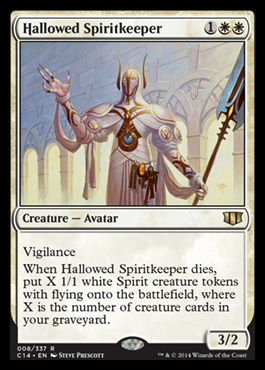
Hallowed Spiritkeeper: As a card without consideration for anything else in your cube, Hallowed Spiritkeeper seems good. A 3/2 vigilence for 1WW is fine, and the dying clause is pretty nuts. In an empty GY he gives you one flier, and the further you get the harder the beating. Wrath? Army. Late game spot removal? Army. Army? Uh…army. Turning your 3/2 into fliers will spell certainly doom, and with Recurring Nightmare Hallowed Spiritkeeper seems like a lot of fun.
As a card with consideration for anything else in your cube, is this better than the other white 3 drops? I’d say it’s not better than: Brismaz, a strong threat on its own which doesn’t replace itself when it dies but can win games on his own; Blade Splicer, a lot of damage that performs better in the same recursion decks; Mirror Entity, which fits a specific role and is one of the reasons you try to play that deck; Flickerwhisp, which is pretty close IMO but gets the nod by enabling the blinks; Mirran Crusader, which I like as a unique paladin variant that’s gross with equipment; and Silverblade Paladin, because apparently I am a sucker for double strike. Beyond those guys, do you need him? At what size cube is he playable? Or is he just better than a lot of them? 5 years ago Hallowed Spiritkeeper is an easy include, but we don’t live in a Time Machine world unfortunately.
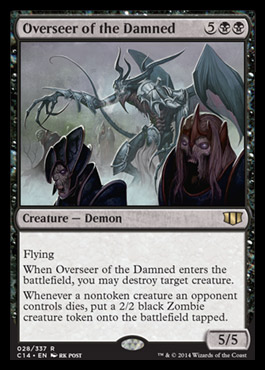
Overseer of the Damned: A cool card that will probably net you some value, but it’s kind of boring for a 7 drop/reanimator target. There are dream worlds where you Recurring Nightmare this card to either amass a giant army or clear away what they have, but there are cheaper token makers and 187 creatures. I think I’d want a bigger body too; call that greedy, but this is cube where you need to be greedy.
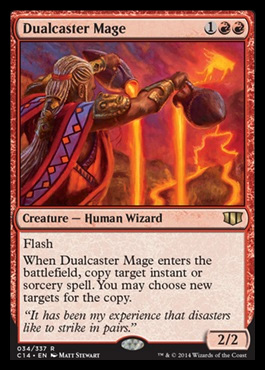
Dualcaster Mage: Typically I’m pretty good with letting go of a card that doesn’t seem great outside of best case scenarios. Dualcaster seems like one of these guys, but I really want Dualcaster Mage to be good! There is something awesome about copying spells, whether it’s yours or your opponents, and I want that ability in my cube. But at three mana, is this guy better than the unplayed Fork? How many red decks are going to be able to have 1RR + another spell open without being too red/clunky? And is he too expensive for mono red? How many non-mono red cards can we really run here? There are a lot of cheap instants and sorceries that you will want to copy, especially in red, and as a 4 or 5 drop in those aggressive decks he could be fine as an EOT Keldon Champion, but is that always going to be the case?
The more you support “spells matter” the better Dualcaster will probably be. This means you run cards like Talrand, Young Pyromancer (who is fine outside of the spells-matter deck but is certainly an all-star in it), Guttersnipe, etc. A majority of cubes don’t run that archetype, but more and more are popping up as Wizards keeps on printing Delver-type cards and his homies. Time will only tell with testing if Dualcaster Mage is only for cubes with the spells-matter deck available or if he’s still good if you’re not running 10-15 instants/sorceries in your deck.
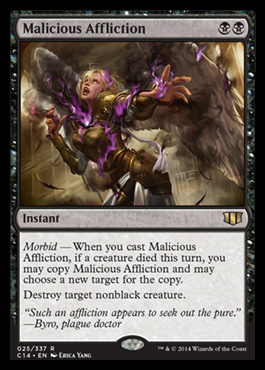
Malicious Affliction: Last but not least, Malicious Affliction is a one-way ticket to value town. Things die, and black is much better at making sure things are dying on both sides of the table than other colors. In pre-and-post combat it should not be an issue turning Malicious Affliction into a 2-for-1. BB is a bit painful, but the upside seems to be worth it. If you can’t trigger morbid, Doom Blade has been a fine cube card since the day it was printed and there’s no reason we should be upset about 1 for 1 removal. The larger the cube the easier it is to include Malicious Affliction, though I have a feeling that double black won’t be enough to stop the affliction from reaching the smallest of cubes. A sometimes effortless, sometimes minimal effort built-in 2 for 1 has to be good enough for cube, right?
Did I miss any? Let us know in the comments, and thanks for reading!

